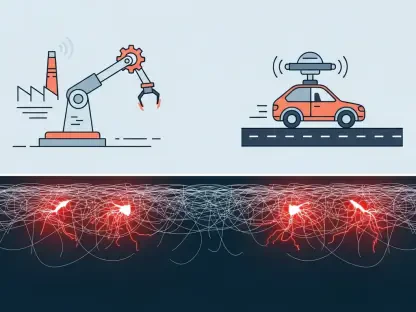I’m thrilled to sit down with Vladislav Zaimov, a seasoned telecommunications specialist with deep expertise in enterprise solutions and risk management for vulnerable networks. With years of experience in the field, Vladislav offers a unique perspective on the latest advancements in public and private network infrastructure. Today, we’ll dive into some groundbreaking projects that highlight the transformative power of 5G technology, from port digitalization to urban connectivity, and explore how these initiatives are shaping the future of telecom.
How would you describe the significance of recent milestones in both public and private network deployments, and what do they reveal about the versatility of modern telecom solutions?
These recent milestones are a testament to the incredible potential of telecom to address diverse needs across different environments. On one hand, you have private 5G networks revolutionizing industrial operations, like at major ports, where tailored connectivity drives efficiency. On the other, public deployments, such as small cell rollouts in urban centers, are enhancing mobile experiences for millions. What stands out is the adaptability—telecom solutions today can be customized for a port’s logistical challenges or a city’s high-density demands, showcasing expertise in both controlled, private settings and complex, shared infrastructures.
Can you walk us through the goals of implementing a private 5G network at a major container port like the one in the Canary Islands?
Absolutely. The primary goal at a facility like the Port of Las Palmas is to digitalize operations for better efficiency and safety. This means connecting critical equipment—think massive cranes that handle container movement—to a reliable, high-speed network. The 5G setup enables real-time data exchange for monitoring and control, streamlines logistics, and supports workers with mobile tools for maintenance. It’s about creating a smarter, more responsive port environment that can handle high volumes while minimizing downtime or errors.
How does 5G technology specifically enhance the digitalization of heavy equipment like cranes at such ports?
5G brings ultra-low latency and high bandwidth, which are game-changers for equipment like rubber-tired gantry cranes or ship-to-shore cranes. These machines often have onboard computers positioned at extreme heights—sometimes over 100 meters up. With 5G, you can transmit data instantly between ground operations and these systems for precise control and monitoring. It eliminates the lag that could lead to operational hiccups, ensuring smoother handling of containers and reducing the risk of accidents or delays.
What are some of the cost advantages of using 5G over traditional fiber optic connections in these port environments?
The cost savings with 5G are significant, especially for tall structures like cranes. Installing fiber optic cables at heights of 20 to 100 meters is not only expensive but also labor-intensive and time-consuming. You need specialized equipment and crews to run those cables safely. 5G, on the other hand, uses wireless access points to deliver connectivity, slashing the need for physical infrastructure. This cuts down on installation and maintenance expenses, making it a more scalable and flexible solution for dynamic port operations.
How are port workers benefiting from tools like 5G-compatible tablets in their daily tasks?
These tablets are transforming how workers manage logistics and maintenance. With 5G, they have real-time access to data—think container tracking, scheduling updates, or equipment diagnostics—right at their fingertips, no matter where they are on the port. It speeds up decision-making, reduces errors in container placement, and allows for instant reporting of maintenance issues. It’s a huge leap from older, slower systems, empowering workers to be more efficient and responsive in a fast-paced environment.
Shifting to urban connectivity, can you explain the concept of a neutral host system and its importance in cities like London?
A neutral host system is essentially a shared infrastructure model where a third party, like a telecom provider, builds and manages a network that multiple mobile operators can use. In a city like London, where space and resources are tight, it’s crucial. Instead of each operator installing their own equipment, a neutral host deploys small cells or other assets that everyone can tap into. This cuts down on clutter, reduces costs, and speeds up rollout, while ensuring better coverage and capacity for users across different networks in busy urban areas.
What impact have recent small cell deployments had on mobile network performance in high-traffic areas of London?
The rollout of over 200 5G small cells in key London spots like King’s Cross and Waterloo has been a major boost. These small cells are designed to handle high user density, especially in areas with heavy foot traffic or during peak times. They increase network capacity and improve data speeds, so people experience fewer dropped calls or buffering issues. It’s about keeping up with the demand for constant connectivity in a city where millions rely on mobile networks every day for work and personal use.
How have strategic partnerships, like access to existing infrastructure, facilitated these urban deployments?
Partnerships, such as leveraging Transport for London’s underground ducts and fiber network, have been a game-changer. Access to over 80,000 street assets and hundreds of miles of existing infrastructure means we can deploy small cells without digging up sidewalks or navigating lengthy permitting processes. It’s a massive time and cost saver, allowing for quicker rollouts and less disruption to the city while still delivering robust connectivity where it’s needed most.
Looking at the technology behind these projects, how do collaborations with equipment providers enhance the design and operation of private 5G networks?
Collaborations with tech providers, like those supplying cutting-edge gear and platforms, are vital. For instance, using advanced digital automation tools allows us to design private 5G networks with precision, ensuring they meet specific industrial needs. These platforms help manage network performance, optimize resource allocation, and troubleshoot issues in real time. It’s about marrying hardware and software expertise to create a seamless, reliable network that can handle the unique demands of a port or other critical facilities.
What’s your forecast for the future of 5G deployments in both industrial and urban settings over the next few years?
I see 5G continuing to redefine both industrial and urban landscapes at an accelerated pace. In industrial settings, we’ll likely see wider adoption of private networks for automation—think smarter factories, ports, and logistics hubs where everything is interconnected. In urban areas, the focus will be on densification, with more small cells and neutral host models to support growing data demands and emerging tech like augmented reality or IoT. The challenge will be balancing scalability with sustainability, but I’m optimistic that innovations in energy efficiency and spectrum use will keep pushing the boundaries of what’s possible.









